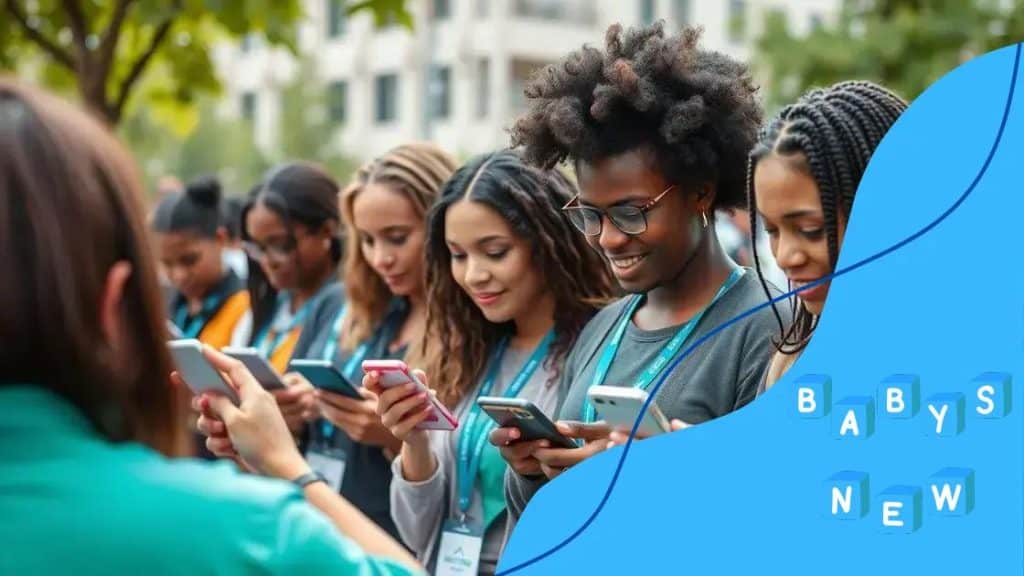Social media’s role in public health: a game changer

Advertisement
Social media plays a crucial role in public health by facilitating real-time communication, enhancing community engagement, and effectively spreading health information while also presenting challenges like misinformation and varied access.
Social media’s role in public health is increasingly significant, especially in today’s connected world. Have you ever wondered how platforms like Facebook or Twitter shape health awareness? Let’s dive into this fascinating topic.
The influence of social media on public health messaging
Social media has transformed how we communicate, and its influence on public health messaging is nothing short of remarkable. By providing a platform for sharing vital health information rapidly, it helps to bridge the gap between health organizations and the public.
This influence is evident in the way messages can be tailored, shared, and amplified across diverse audiences. Organizations can utilize social media to spread awareness on crucial health topics, such as vaccination, disease prevention, and healthy lifestyle choices. Now, let’s delve deeper into this pivotal role.
Advertisement
The power of social media platforms
Each platform offers unique characteristics that can enhance public health messaging. For instance:
- Instagram: Great for visual storytelling using images and videos.
- Twitter: Ideal for real-time updates and health alerts.
- Facebook: Useful for community engagement and sharing resources.
By understanding how to leverage the strengths of these platforms, health organizations can craft messages that resonate more effectively with their audiences. The objective is to create content that not only informs but also encourages action among individuals.
The impact of social media extends beyond simple sharing. It creates opportunities for dialogue and interaction. People can ask questions, share experiences, and provide feedback on health topics, fostering a sense of community around public health issues. This direct engagement can significantly enhance trust and credibility for health messages.
Advertisement
Challenges faced in social media messaging
Despite the advantages, there are also challenges in using social media for health messaging:
- Misinformation can spread quickly, often overshadowing factual information.
- Not all demographics use social media equally, leading to gaps in outreach.
- Health organizations must maintain professionalism while being approachable and relatable.
Addressing these challenges requires continual learning and adaptation. Public health messages must be crafted with a deep understanding of the target audience, ensuring they are clear, accessible, and actionable.
The way social media influences public health messaging is critical for improving community health outcomes. By employing strategic communication tactics and fostering open dialogue, we can make strides toward better health awareness and education.
How social media helps track health trends
Social media plays a vital role in tracking health trends, making it easier for public health officials and researchers to understand the pulse of community health. By analyzing data shared on platforms like Twitter, Facebook, and Instagram, valuable insights can be gleaned about emerging health issues and public perceptions.
For instance, health organizations can monitor posts about flu symptoms to identify outbreaks early. This real-time tracking allows for quicker responses and targeted interventions. Data analytics tools can sift through massive amounts of user-generated content, pinpointing hotspots of health concerns effectively.
The role of hashtags in health monitoring
Hashtags are essential in gathering data on health trends. They organize conversations around specific topics. For example:
- #FluSeason: People sharing experiences and symptoms during the flu season.
- #VaccineAwareness: Discussions about vaccines can highlight public sentiment and misinformation.
- #MentalHealthMatters: This shows how users are addressing mental health challenges.
Such hashtags allow researchers to track conversations and gauge community engagement regarding public health issues. Additionally, they enable public health campaigns to engage directly with communities.
The sentiment expressed through posts can reveal how people feel about certain health issues. For example, if many individuals express concern about a new disease outbreak, it shows a need for public information campaigns to address fears and misinformation.
Using social media analytics for insights
Platforms provide analytics tools that can help agencies identify trending topics, keywords, and overall engagement levels. These analytics can show:
- What health topics are most discussed.
- The demographics of individuals engaging in these discussions.
- How quickly information spreads across networks.
By analyzing these trends, organizations can adapt their health strategies to meet the current needs and concerns of the public. It ensures that health messaging is relevant and timely, improving the overall effectiveness of public health campaigns.
Ultimately, social media is not just a communication tool but a powerful platform for tracking and understanding health trends in real time. This approach allows better planning and response strategies in public health initiatives.
Building community engagement through social media campaigns

Engaging the community is vital for public health success, and building community engagement through social media campaigns is one of the most effective strategies. By utilizing social media, health organizations can interact with the public, creating a two-way communication channel that fosters trust and collaboration.
Health campaigns that actively involve the community can drive awareness and encourage healthy behaviors. For example, campaigns that ask for community input not only make residents feel valued but also provide insights into their needs and concerns.
Strategies for effective engagement
To effectively engage the community, health campaigns can employ various strategies:
- Interactive posts: Use polls and questions to stimulate discussion.
- Community stories: Share testimonials and stories from local residents, highlighting health successes.
- Live Q&A sessions: Host sessions allowing community members to ask health experts directly about pressing topics.
These strategies create interactive environments that encourage participation and provide valuable feedback. Engaging individuals where they already spend time reinforces public health messages in relatable ways.
Social media allows organizations to target specific groups within the community effectively. Utilizing data analytics can help identify which demographics are most active on particular platforms, enabling tailored messaging that resonates with them. This approach not only increases engagement but also enhances the reach of health initiatives.
Measuring the impact of community engagement
Tracking the effectiveness of social media campaigns is essential. Organizations can measure engagement in several ways:
- Analyzing likes, shares, and comments to gauge interest in specific topics.
- Monitoring participation rates during live events or discussions.
- Collecting feedback through surveys to understand public perception post-campaign.
These metrics can guide future campaigns, ensuring they meet the community’s evolving needs and interests. By continually adapting strategies based on feedback and data, public health organizations can enhance their impact.
Building community engagement through social media campaigns is a powerful tool that fosters connection and awareness. By placing people at the center of these initiatives, organizations can cultivate a healthier, more informed community.
Challenges and limitations of social media in health communications
While social media has revolutionized health communications, it comes with its own set of challenges and limitations that can impact effectiveness. Understanding these challenges is crucial for maximizing the benefits of using social media in public health efforts.
One major limitation is the spread of misinformation. False information can quickly circulate on platforms like Twitter and Facebook, leading to confusion and distrust among the public. For instance, incorrect claims about vaccines can deter individuals from getting vaccinated and harm community health.
Other critical challenges include:
- Privacy concerns: Personal health information is often shared on social media, raising issues about confidentiality and data security.
- Platform biases: Some platforms may limit the reach of certain types of health messages, affecting who sees important information.
- Digital divide: Not everyone has equal access to the internet or social media, meaning some populations might be left out of key health communications.
Navigating these challenges requires a thoughtful approach. Health organizations must actively monitor the information shared on their platforms and correct misconceptions promptly. Creating clear and engaging content can help attract attention and mitigate the effects of misinformation.
Another challenge is the fast-paced nature of social media. Health trends can change rapidly, making it difficult for organizations to keep their messaging up to date. Regularly refreshing content and staying informed about the latest developments in health topics is essential for relevance.
Addressing limitations in health communications
To effectively communicate health messages, organizations must also foster a culture of skepticism and critical thinking among their audiences. Educating the public on how to identify credible information sources becomes vital in combating misinformation. Encouraging users to verify health information before sharing can significantly reduce the spread of false claims.
Ultimately, while social media presents notable challenges and limitations in health communications, it also offers unique opportunities for engagement and awareness. Being aware of potential pitfalls allows organizations to develop strategies that enhance their messaging and reach.
Case studies: Successful public health campaigns on social media
Examining case studies of successful public health campaigns on social media provides valuable insights into how effective communication can promote health awareness and behavior change. These campaigns highlight innovative strategies that resonate with audiences and lead to meaningful engagement.
One notable example is the Ice Bucket Challenge, which went viral and raised funds for ALS research. Participants challenged friends to pour ice water over themselves and share the video online, raising awareness and encouraging donations. This campaign showed how a fun and interactive approach can mobilize a community for a cause.
Another successful campaign is:
- Truth Initiative: This anti-smoking campaign utilized social media to target young people effectively. By using eye-catching graphics and engaging content, it educated youth about the dangers of smoking and the tactics used by tobacco companies.
- CDC’s #TipsFromFormerSmokers: This campaign shared real stories from former smokers, detailing their struggles with health problems caused by smoking. Personal narratives were powerful tools that resonated with audiences, emphasizing the reality of health consequences.
These case studies illustrate the importance of creativity and relatability in public health messaging. Social media’s unique ability to engage users interactively makes it an ideal platform for outreach. Leveraging trends, humor, and personal stories can significantly enhance campaign effectiveness.
Additionally, collaboration with influencers and community leaders can amplify the reach of these campaigns. When trusted figures share health messages, it builds credibility and encourages wider participation. This collaborative approach can transform health communications into community-wide efforts to promote wellness and education.
Analyzing the outcomes
Measuring the success of these campaigns provides insights into what works. Metrics like engagement rates, shares, and changes in public behavior are crucial for evaluating impact. For instance, assessing how many people participated in the Ice Bucket Challenge provides data on awareness and fundraising success.
Using analytics tools can help organizations understand audience responses better, allowing for continuous improvement in future campaigns. In the ever-evolving social media landscape, adapting strategies based on feedback ensures that public health messages remain relevant and impactful.
FAQ – Frequently Asked Questions about Social Media in Public Health
How has social media changed public health communications?
Social media allows for real-time sharing of health information, enabling organizations to reach a wider audience and engage communities more effectively.
What are some successful examples of health campaigns on social media?
Campaigns like the Ice Bucket Challenge and the CDC’s #TipsFromFormerSmokers have effectively raised awareness and encouraged healthier behaviors.
What challenges do public health organizations face on social media?
Challenges include misinformation, privacy concerns, and the digital divide, which can hinder effective communication and outreach.
How can organizations measure the success of social media campaigns?
Organizations can track engagement rates, shares, and public behavior changes to determine the effectiveness of their campaigns.





